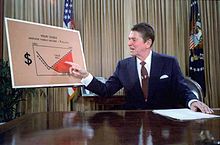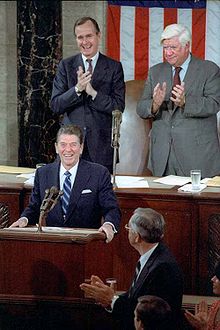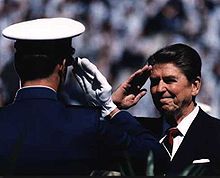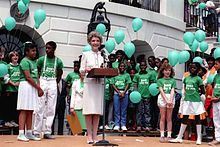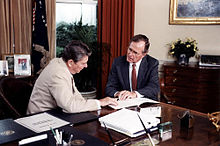- Domestic policy of the Ronald Reagan administration
-
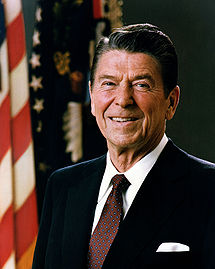 President Ronald Reagan
President Ronald Reagan
The Domestic policy of the Ronald Reagan administration was the domestic policy in the United States from 1981 to 1989 under President Ronald Reagan. It retained conservative values economically, beginning with the president's implementation of his supply-side economic policies, dubbed Reaganomics by both supporters and detractors. His policies included the largest tax cut in American history, as well as increased defense spending. Notable events included his firing of nearly 12,000 striking air traffic control workers and appointing the first woman to the Supreme Court bench, Sandra Day O'Connor. He believed in federalism, and passed policies to encourage development of private business, routinely criticizing and defunding the public sector. He greatly accelerated the nation's War on Drugs.[1]
Contents
"Reaganomics" and the economy
Main article: ReaganomicsPolicies
Based on supply-side economics, Reagan implemented his economic policies in 1981. The four pillars of the policies were to:[2]
- reduce the growth of government spending;
- reduce marginal tax rates on income from labor and capital;
- reduce regulation;
- control the money supply to reduce inflation.
By reducing or eliminating decades-long social programs and significantly increasing defense spending, while at the same time lowering taxes, Reagan's approach to handling the economy marked a significant departure from that of his predecessors.[2]
When Reagan entered office, the country faced the highest rate of inflation since 1947 (11.83% in January 1981)], and high interest rates. These were considered the nation's principal economic problems, and are all components of "stagflation." Reagan sought to stimulate the economy with large, across-the-board tax cuts[2][3][4] The expansionary fiscal policies soon became known as "Reaganomics",[3] and were considered by some to be the most serious attempt to change the course of U.S. economic policy of any administration since the New Deal.[2]
Economic record
President Reagan's tenure marked a time of economic prosperity for many Americans. However, the number of Americans below the poverty level increased from 29.272 million in 1980 to 31.745 in 1988, which means that, as a percentage of the total population, it remained almost stationary, from 12.95% in 1980 to 13% in 1988.[5] The number of children, ages 18 years and younger, below the poverty level increased from 11.543 million in 1980, 18.3% of children, to 12.455, 19.5%, in 1988.[6] In addition, the situation of low income groups was affected by the reduction of social spending. Inequality also increased. The share of total income received by the 5% highest-income households grew from 16.5% in 1980 to 18.3% in 1988 and the share of the highest fifth of income increased from 44.1% to 46.3% in same years. In contrast, the share of total income of the lowest fifth of households fell from 4.2% in 1980 to 3.8% in 1988 and the second poorest fifth from 10.2% to 9.6%.[7]
After negotiations with the Republican-controlled Senate and the Democratic-controlled House, in August 1981, President Reagan signed the bipartisan largest tax cuts in American history into effect at his California ranch. This lowered income taxes significantly, with the top personal tax bracket dropping from 70% to 28% during the course of seven years.[8] Due to a recession in 1982, unemployment rose to over 10%, only to drop during the rest of Reagan's terms, averaging 7.5%,[4][9][10] while the gross domestic product (GDP) growth recovered and grew at a rate of 3.4% annually.[11][12] Inflation significantly decreased, falling from 13.6% in 1980 (President Carter's final year in office) to 4.1% by 1988.[12] Sixteen million new jobs were created as well.[13] The net effect of all Reagan-era tax bills resulted in a 1% decrease of government revenues (as a percentage of GDP), with the revenue-shrinking effects of the 1981 tax cut (-3% of GDP) and the revenue-gaining effects of the 1982 tax hike (~+1% of GDP), while subsequent bills were more revenue-neutral.[14]
During the Reagan Administration, federal receipts grew at an average rate of 8.2% (2.5% attributed to higher Social Security receipts), and federal outlays grew at an annual rate of 7.1%.[15][16]
Reagan's administration is the only one not to have raised the minimum wage by its conclusion.[17]
Along with these, Reagan reappointed Paul Volcker as Chairman of the Federal Reserve, as well as the monetarist Alan Greenspan to succeed him in 1987. He preserved the core New Deal safeguards, such as the United States Securities and Exchange Commission (SEC), Federal Deposit Insurance Corporation (FDIC), the GI Bill and Social Security, while rolling back what he viewed as the excesses of 1960s and 1970s liberal policies.
The policies were labeled by some as "Trickle-down economics,"[18] due to the facts that the combination of significant tax cuts and a massive increase in Cold War related defense spending caused large budget deficits,[19] the U.S. trade deficit expansion,[19] as well as the stock market crash of 1987, and contributed to the Savings and Loan crisis.[20] The ultimate cost of the Savings and Loan crisis is estimated to have totaled around US$150 billion, about $125 billion of which was consequently and directly subsidized by the U.S. government. John Kenneth Galbraith called it "the largest and costliest venture in public misfeasance, malfeasance and larceny of all time."[21] In order to cover new federal budget deficits, the United States borrowed heavily both domestically and abroad, raising the national debt from $997 billion to $2.85 trillion,[22] and the United States moved from being the world's largest international creditor to the world's largest debtor nation.[23] Reagan described the new debt as the "greatest disappointment" of his presidency.[24]
Reagan's support for an increased defense budget at the height of the Cold War was supported by Congressional Democrats and Republicans. However, Congress was reluctant to follow Reagan's proposed cuts in domestic programs. In accordance with Reagan's less-government intervention views, many domestic government programs were cut or experienced periods of reduced funding during his presidency.[25] These included Social Security, Medicaid, Food Stamps, and federal education programs.[26] Though Reagan protected entitlement programs, such as Social Security and Medicare,[27] in one of the most widely criticized[28] actions of the administration, the administration attempted to purge tens of thousands of allegedly disabled people from the Social Security disability roles, who the administration alleged were not truly disabled.[28] Funding for government organizations, including the Environmental Protection Agency, were also reduced.[29] He cut the EPA's budget by 22%, and his director of the EPA, Anne M. Burford, resigned over alleged mismanagement of funds.[30] Tax breaks and increased military spending resulted in an increase of the national budget deficit and led Reagan and Congress to approve two tax increases, aiming to preserve funding for Social Security, though not as high as the 1981 tax cuts.[31]
Speaking of Reagan himself, Donald Regan, the President's former Secretary of the Treasury, and later Chief of Staff, criticized him for his supposed lack of understanding of economics: "In the four years that I served as Secretary of the Treasury, I never saw President Reagan alone and never discussed economic philosophy or fiscal and monetary policy with him one-on-one.... The President never told me what he believed or what he wanted to accomplish in the field of economics."[32] However, Reagan's chief economic adviser Martin Feldstein, argues the opposite: "I briefed him on Third World debt; he didn't take notes, he asked very few questions.... The subject came up in a cabinet meeting and he summarized what he had heard perfectly. He had a remarkably good memory for oral presentation and could fit information into his own philosophy and make decisions on it.[33]
Oil policy
At the beginning of his presidency, Reagan ended the price controls on domestic oil which had been started by Richard Nixon; they had contributed to both the 1973 Oil Crisis and the 1979 Energy Crisis.[34][35] The price of oil subsequently dropped, and the 1980s did not see the gasoline lines and fuel shortages that the 1970s had.[35] Reagan also attempted to make good on his 1980 campaign promise to repeal the "Windfall Profit Tax" that Carter and Congress enacted in 1980 on domestic oil production; he was able to do so in 1988, when Congress agreed that it had increased dependence on foreign oil.[36] The tax was not a tax on profits, but an excise tax on the difference between a statutory "base price" and the market price.[37] Reagan also stopped aggressive pushing of new auto efficiency standard by Carter administration, descended on alternative energy researches started by Carter administration. However, fuel efficiency in cars and light trucks driven by Americans still increased by a larger amount between 1980 and 1990 compared to previous decades or the decades since.[38]
Legacy
Some economists agree that Reagan's tax policies invigorated America's economy, such as Nobel Prize winner Milton Friedman, who wrote that the Reagan tax cuts were "one of the most important factors in the boom of the 1990s." Similarly, fellow Nobel Prize winning economist Robert A. Mundell wrote that the tax cuts "made the U.S. economy the motor for the world economy in the 1990s, on which the great revolution in information technology was able to feed."[39] Other economists argue that the deficits slowed economic growth during the following administration[40] and was the reason that Reagan's successor, George H.W. Bush, reneged on a campaign promise and raised taxes. Nobel prize winning economist Robert Solow stated, "As for Reagan being responsible [for the 1990s boom], that's far-fetched. What we got in the Reagan years was a deep recession and then half a dozen years of fine growth as we climbed out of the recession, but nothing beyond that."[39]
Another Reagan legacy was the expansion of Alternative Minimum Tax from a law for untaxed rich investors to one refocused on middle class Americans.[41] When Ronald Reagan signed the Tax Reform Act of 1986, the AMT was expanded to target middle class deductions related to having children, owning a home, or living in high tax states. In 2006, the IRS's National Taxpayer Advocate's report highlighted the AMT as the single most serious problem with the tax code. The advocate noted that the complexity of the AMT leads to most taxpayers who owe AMT not realizing it until preparing their returns or being notified by the IRS.[42]
Environment
Reagan dismissed acid rain and proposals to halt it as burdensome to industry.[43] The Environmental Protection Agency implored Reagan to make a major budget commitment to reduce acid rain; Reagan rejected the proposal and deemed it as wasteful government spending.[44] He also questioned scientific evidence on the causes of acid rain.[44] It was later discovered that the administration was releasing Superfund grants for cleaning up local toxic waste sites to enhance the election prospects of local officials aligned with the Republican Party.[45] Reagan rarely thought about the environment in political terms, however, and did not fear that his popularity would be damaged by environmental issues.[44]
The HUD controversy involved administration staffers granting federal funding to constituents, and defrauding the U.S. government out of money intended for low income housing. It resulted in six convictions, including James G. Watt, Reagan's Secretary of the Interior. Watt was indicted on 24 felony counts and pled guilty to a single misdemeanor. He was sentenced to five years probation, and ordered to pay a $5000 fine.[46]
Unions and corporations
In 1981, to protect domestic auto sales the Reagan administration signed an agreement with Japan that it would not import more than 1.67 million cars into the United States, which would be one in four cars sold in America.[47]
Air traffic controllers' strike
Main article: Professional Air Traffic Controllers Organization (1968)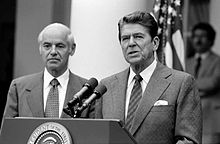 President Reagan speaks about the strike during a press conference in the White House Rose Garden. Reagan fired 11,345 strikers who did not return to work.
President Reagan speaks about the strike during a press conference in the White House Rose Garden. Reagan fired 11,345 strikers who did not return to work.
striking.[48] Reagan announced that the situation had become an emergency as described in the 1947 Taft Hartley Act, and held a press conference on August 3, 1981 in the White House Rose Garden regarding the strike. Reagan stated that if the air traffic controllers "do not report for work within 48 hours, they have forfeited their jobs and will be terminated."[49]
Two days later, on August 5, Reagan fired 11,359 striking air traffic controllers who had ignored his order to return to work, notwithstanding the fact that the strike was illegal under federal law. The breaking of the strike had a significant impact on labor-management relations in the private sector. Although private employers nominally had the right to permanently replace striking workers under the National Labor Relations Act, that option was rarely used prior to 1981, but much more frequently thereafter. Reagan's actions essentially broke the striking union.[50]
Military
Reagan sharply accelerated the massive military build up started by the Carter administration in response to the Soviet intervention in Afghanistan.[51] This buildup, a 40% real increase in defense spending,[52] included the revival of the B-1 bomber program, which had been cancelled by the Carter administration;[53] the deployment of Pershing II missiles in West Germany; the increased enlistment of thousands of troops; and a more advanced intelligence system.[53]
Strategic Defense Initiative
In 1983, Reagan introduced the Strategic Defense Initiative (SDI), a defense project. The intended goal was to make the US invulnerable to a Soviet missile attack by placing missiles in space and vaporizing those of the Soviets, upon a nuclear attack.[53] This would be done by a laser guidance system, which grew into a series of systems that turned into a layered ballistic missile defense.[53] Dubbed "Star Wars" by the news media, many wondered if the technological objective was attainable. Following air defense laser testing in 1973, work continued throughout the 1980s, and the first above earth test laser intercept was completed.[53]
The arts
Though Ronald and Nancy Reagan were both former actors and he had served as president of the Screen Actor's Guild, his administration had a curiously mixed record on support for the arts. Via a 1982 Executive Order, President Reagan established the President's Committee on the Arts and Humanities. In each year of his presidency (except for the fiscal years of 1982 and 1986), Congress staved off the Administration's efforts to cut federal expenditures for arts programs such as the National Endowment for the Arts.[54] In a 1983 speech he declared, "We support the National Endowment for the Arts to stimulate excellence and make art more available to more of our people,"[55] yet throughout his administration, beginning with an early threat to cut the Carter-era arts budget in half[56], Reagan's economic and social agendas put him at odds, often contentiously, with artists and arts communities nationwide.[57]
War on Drugs
Not long after being sworn into office, Reagan declared more militant policies in the "War on Drugs".[58][59] He promised a "planned, concerted campaign" against all drugs,[60] eventually leading to decreases in adolescent drug use in America.[61][62]
President Reagan signed a large drug enforcement bill into law in 1987; it granted $1.7 billion to fight drugs, and ensured a mandatory minimum penalty for drug offenses.[63] The bill was criticized for promoting significant racial disparities in the prison population, however, because of the differences in sentencing for crack versus powder cocaine.[63]
Critics also charged that the administration's policies did little to actually reduce the availability of drugs or crime on the street, while resulting in a great financial and human cost for American society.[64] Supporters argued that the numbers for adolescent drug users declined during Reagan's years in office.[62]
As a part of the administration's effort, Reagan's First Lady, Nancy, made the War on Drugs her main cause as First Lady, by founding the "Just Say No" drug awareness campaign. Today, there are still hundreds of "Just Say No" clinics and school clubs in operation around the country aimed at helping and rehabilitating children and teenagers with drug problems.[63] The program demonstrated to children various ways of refusing drugs and alcohol.
The Judiciary
Reagan nominated Sandra Day O'Connor to fill the Supreme Court Justice vacancy left by the retirement of Justice Potter Stewart, as he had promised during his 1980 presidential campaign. Sandra Day O'Connor was a conservative Republican and strict constructionist. Though the far-right of the Republican Party was dissatisfied by O'Connor, who refused to condemn the Roe v. Wade decision and had supported the federal Equal Rights Amendment, Senate Republicans and the vast majority of Americans approved of the pick, the Senate confirming her unanimously. O'Connor would later take more moderate positions.[65]
In 1986, during his second term, the president elevated Justice William Rehnquist to succeed outgoing Chief Justice Warren Burger and named Antonin Scalia to occupy the seat left by Rehnquist.
In 1987, when Associate Justice Louis Powell retired, Reagan nominated conservative jurist Robert Bork to the high court. Within 45 minutes of Bork's nomination to the Court, Ted Kennedy (D-MA) took to the Senate floor with a strong condemnation of Bork in a nationally televised speech, declaring,
“ Robert Bork's America is a land in which women would be forced into back-alley abortions, blacks would sit at segregated lunch counters, rogue police could break down citizens' doors in midnight raids, schoolchildren could not be taught about evolution, writers and artists could be censored at the whim of the Government, and the doors of the Federal courts would be shut on the fingers of millions of citizens.[66] ” 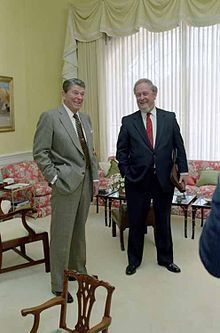 Reagan in the White House private quarters with Robert Bork
Reagan in the White House private quarters with Robert Bork
The rapid response of Kennedy's "Robert Bork's America" speech stunned the Reagan White House; though conservatives considered Kennedy's accusations slanderous ideological smears on a well qualified candidate for the bench,[67] the attacks went unanswered for two and a half months.[68] Bork refused to withdraw himself and his nomination was rejected 58–42.[69] Anthony Kennedy was eventually confirmed in his place.[70]
Reagan also nominated a large number of judges to the United States district court and United States court of appeals benches; most of these nominations were not controversial, although a handful of candidates were singled out for criticism by civil rights advocates and other liberal critics, resulting in occasional confirmation fights. Both his Supreme Court nominations and his lower court appointments were in line with Reagan's express philosophy that judges should interpret law as enacted and not "legislate from the bench". By the end of the 1980s, a conservative majority on the Supreme Court had put an end to the perceived "activist" trend begun under the leadership of Chief Justice Earl Warren.[citation needed] Some[who?] argued that the conservatives justices were equally activist, but that their sympathies with corporate America.[clarification needed] However, general adherence to the principle of stare decisis, along with minority support, left most of the major landmark case decisions (such as Brown, Miranda, and Roe v. Wade) of the previous three decades still standing as binding precedent.
Reagan appointed 83 judges to the United States Courts of Appeals, and 290 judges to the United States district courts. His total of 376 appointments is the most by any president. Reagan appointed many leading conservative academics to the intermediate United States Courts of Appeals, including Bork, Ralph K. Winter, Jr., Richard Posner, and Frank Easterbrook. However, he also experienced a number of judicial appointment controversies, as nine nominees for various federal appellate judgeships were not confirmed. In some cases, the nominations were not processed by the Democratic-controlled Senate Judiciary Committee before Reagan's presidency ended, while in other cases, nominees were rejected by the Senate Judiciary Committee or even blocked by unfriendly members of the Republican Party.
Response to AIDS
Perhaps the greatest criticism surrounds Reagan's silence about the AIDS epidemic spreading in the 1980s. Although AIDS was first identified in 1981, Reagan did not mention it publicly for several more years, notably during a press conference in 1985 and several speeches in 1987. During the press conference in 1985, Reagan expressed skepticism in allowing children with AIDS to continue in school, stating:
It is true that some medical sources had said that [HIV] cannot be communicated in any way other than the ones we already know and which would not involve a child being in the school. And yet medicine has not come forth unequivocally and said, 'This we know for a fact, that it is safe.' And until they do, I think we just have to do the best we can with this problem.[71]The CDC had previously issued a report stating that "casual person-to-person contact as would occur among schoolchildren appears to pose no risk."[72] During his 1987 speeches Reagan supported modest educational funding on AIDS,[73] increased AIDS testing for marriage licenses and mandatory testing for high risk groups.[74][75]
Even with the death from AIDS of his friend Rock Hudson, Reagan was widely criticized[citation needed] for not supporting more active measures to contain the spread of AIDS. Until celebrity Elizabeth Taylor spoke out publicly about the monumental amount of people quickly dying from this new disease, most public officials and celebrities were too afraid of dealing with this subject.
Possibly in deference to the views of the powerful religious right,[citation needed] which saw AIDS as a disease limited to the gay male community and spread by "immoral" behavior, Reagan prevented his Surgeon General, C. Everett Koop, from speaking out about the epidemic.[citation needed] When in 1986 Reagan was highly encouraged by many other public officials to authorize Koop to issue a report on the epidemic, he expected it to be in line with conservative policies; instead, Koop's Surgeon General's Report on Acquired Immune Deficiency Syndrome greatly emphasized the importance of a comprehensive AIDS education strategy, including widespread distribution of condoms, and rejected mandatory testing. This approach brought Koop into conflict with other administration officials such as Education Secretary William Bennett.
Social action groups such as ACT UP worked to raise awareness of the AIDS problem. Because of ACT UP, in 1987, Reagan responded by appointing the Watkins Commission on AIDS, which was succeeded by a permanent advisory council.
LGBT Rights
No civil rights legislation for LGBT individuals passed during Reagan's tenure. On the 1980 campaign trail, he spoke of the gay civil rights movement:
My criticism is that [the gay movement] isn’t just asking for civil rights; it’s asking for recognition and acceptance of an alternative lifestyle which I do not believe society can condone, nor can I.[76]Civil Rights
Reagan opposed the Civil Rights Act of 1964 and the Voting Rights Act of 1965 signed into law by President Lyndon B. Johnson.
Reagan gave a States' Rights speech at the Neshoba County Fair in Philadelphia, Mississippi, the town where three civil rights workers were murdered in 1964, when running for president in 1980 (many politicians had spoken at that annual Fair, however). Reagan was offended that some accused him of racism. In 1980 Reagan said the Voting Rights Act was "humiliating to the South", although he later supported extending the Act. He opposed Fair Housing legislation in California (the Rumford Fair Housing Act), but in 1988 signed a law expanding the Fair Housing Act of 1968. Reagan was unsuccessful in trying to veto another civil rights bill in March of the same year. At first Reagan opposed the Martin Luther King holiday, and signed it only after an overwhelming veto-proof majority (338 to 90 in the House of Representatives and 78 to 22 in the Senate) voted in favor of it. Congress overrode Reagan's veto of the Civil Rights Restoration Act of 1988. Reagan said the Restoration Act would impose too many regulations on churches, the private sector and state and local governments.
References
- ^ "The Reagan Presidency". Ronald Reagan Presidential Foundation. http://www.reagan.utexas.edu/archives/reference/pressketch.html. Retrieved 2008-03-21.
- ^ a b c d William A. Niskanen. "Reaganomics". The Concise Encyclopedia of Economics. http://www.econlib.org/library/Enc/Reaganomics.html. Retrieved 2007-05-22.
- ^ a b Cannon, Lou (2001) p. 99
- ^ a b Appleby, Joyce (2003), pp. 923–924
- ^ U.S. Census Bureau, Historical Poverty Tables, table 7.
- ^ U.S. Census Bureau, Historical Poverty Tables, table 3.
- ^ U.S. Census Bureau, Historical Income Tables, table H-2.
- ^ Daniel J. Mitchell, Ph.D. (July 19, 1996). "The Historical Lessons of Lower Tax Rates". The Heritage Foundation. http://www.heritage.org/Research/Taxes/BG1086.cfm. Retrieved 2007-05-22.
- ^ Lipset, Seymour Martin; Schneider, William (Spring, 1987). "The Confidence Gap during the Reagan Years, 1981-1987". Political Science Quarterly (J-STOR) 102 (1): 1. doi:10.2307/2151482. JSTOR 2151482.
- ^ ftp://ftp.bls.gov/pub/suppl/empsit.cpseea1.txt, retrieved 2009-12-17
- ^ "Gross Domestic Product". Bureau of Economic Analysis. May 31, 2007. http://www.bea.gov/national/xls/gdpchg.xls.
- ^ a b William A. Niskanen; Stephen Moore (October 22, 1996). "Supply Tax Cuts and the Truth About the Reagan Economic Record". Policy Analysis. Cato Institute. http://cato.org/pubs/pas/pa-261.html. Retrieved 2007-11-14.
- ^ Anderson, Martin (July 22, 1988). "Streamlining Reaganomics for the 90's". The New York Times. http://query.nytimes.com/gst/fullpage.html?res=940DE2D7173FF931A15754C0A96E948260. Retrieved 2008-03-24.
- ^ Office of Tax Analysis (2003, rev. September 2006) (PDF). Revenue Effects of Major Tax Bills. United States Department of the Treasury. Working Paper 81, Table 2. http://www.ustreas.gov/offices/tax-policy/library/ota81.pdf. Retrieved 2007-11-28.
- ^ http://www.presidency.ucsb.edu/data/budget.php
- ^ http://www.socialsecurity.gov/history/pdf/4a.pdf
- ^ http://www.dol.gov/whd/minwage/chart.htm#footnote, retrieved 27 December 2009.
- ^ Danziger, S.H.; D.H. Weinburg (1994). "The Historical Record: Trends in Family Income, Inequality, and Poverty" in Confronting Poverty: Prescriptions for Change.
- ^ a b Etebari, Mehrun (July 17, 2003). "Trickle-Down Economics: Four Reasons why it Just Doesn't Work". faireconomy.org. http://www.faireconomy.org/research/TrickleDown.html. Retrieved 2007-03-31.
- ^ "The S&L Crisis: A Chrono-Bibliography". Federal Deposit Insurance Corporation. http://www.fdic.gov/bank/historical/s&l/. Retrieved 2007-04-08.
- ^ John Kenneth Galbraith, The Culture of Contentment. (Houghton Mifflin, 1992).
- ^ "Historical Debt Outstanding". U.S. Treasury Department. http://www.treasurydirect.gov/govt/reports/pd/histdebt/histdebt_histo4.htm. Retrieved 8 September 2010.
- ^ "Reagan Policies Gave Green Light to Red Ink". The Washington Post. 2004-06-09. http://www.washingtonpost.com/wp-dyn/articles/A26402-2004Jun8.html. Retrieved 2007-05-25.
- ^ Cannon, Lou (2001) p. 128
- ^ "Ronald Reagan: Presidency – Domestic policies". Encyclopædia Britannica. http://www.britannica.com/EBchecked/topic/492882/Ronald-W-Reagan/214230/Domestic-policies. Retrieved 2008-08-21.
- ^ Rosenbaum, David E (January 8, 1986). "Reagan insists Budget Cuts are way to Reduce Deficit". The New York Times. http://query.nytimes.com/gst/fullpage.html?sec=health&res=9A0DE3DE1630F93BA35752C0A960948260. Retrieved 2008-08-21.
- ^ "The Reagan Presidency". Reagan Presidential Foundation. http://www.reagan.utexas.edu/archives/reference/pressketch.html. Retrieved 2008-08-04.
- ^ a b Pear, Robert (April 19, 1992). "U.S. to Reconsider Denial of Benefits to Many Disabled". The New York Times. http://query.nytimes.com/gst/fullpage.html?res=9E0CE6D81738F93AA25757C0A964958260&sec=&spon=&pagewanted=all. Retrieved 2008-05-23.
- ^ "Views from the Former Administrators". EPA Journal. Environmental Protection Agency. November 1985. http://www.epa.gov/history/topics/epa/15e.htm. Retrieved 2008-08-21.
- ^ Sullivan, Patricia (2004-07-22). "Anne Gorsuch Burford, 62, Dies; Reagan EPA Director". The Washington Post. http://www.washingtonpost.com/wp-dyn/articles/A3418-2004Jul21.html. Retrieved 2008-07-31.
- ^ "Social Security & Medicare Tax Rates". Social Security Administration. December 23, 2002. http://www.ssa.gov/OACT/ProgData/taxRates.html. Retrieved 2007-08-15.
- ^ Regan, Donald T. (1988), p. 142
- ^ Lee, Susan. 1996. Hands Off: Why the Government is a Menace to Economic Health. Simon & Schuster. p. 223
- ^ Brandly, Mark (2004-05-20). "Will We Run Out of Energy?". Ludwig von Mises Institute. http://www.mises.org/story/1519. Retrieved 2008-11-06.
- ^ a b Lieberman, Ben (2005-09-01). "A Bad Response To Post-Katrina Gas Prices". Heritage Foundation. http://www.heritage.org/Research/EnergyandEnvironment/wm827.cfm. Retrieved 2008-11-06.
- ^ Thorndike, Joseph J. (2005-11-10). "Historical Perspective: The Windfall Profit Tax – Career of a Concept". TaxHistory.org. http://www.taxhistory.org/thp/readings.nsf/cf7c9c870b600b9585256df80075b9dd/edf8de04e58e4b14852570ba0048848b. Retrieved 2008-11-06.
- ^ [1], CRS Report RL33305, The Crude Oil Windfall Profit Tax of the 1980s: Implications for Current Energy Policy, by Salvatore Lazzari, p. 5.
- ^ Bureau of Transportation Statistics. "Average Fuel Efficiency of U.S. Cars and Light Trucks". http://www.bts.gov/publications/national_transportation_statistics/html/table_04_23.html. Retrieved 21 December 2010.
- ^ a b "Reagan's Economic Legacy". Business Week. http://www.businessweek.com/magazine/content/04_25/b3888032_mz011.htm. Retrieved 2007-07-01.
- ^ "Exploding Deficits, Declining Growth: The Federal Budget and the Aging of America" (PDF). Committee for Economic Development. Archived from the original on 2007-02-03. http://web.archive.org/web/20070203170129/http://ced.org/docs/report/report_deficit.pdf. Retrieved 2007-07-24.
- ^ "Alternative Minimum Tax". New York Times. 2008. http://topics.nytimes.com/top/reference/timestopics/subjects/a/alternative_minimum_tax/index.html. Retrieved 2008-05-16.
- ^ "National Taxpayer Advocate 2006 Annual Report to Congress-Executive Summary" (PDF). Internal Revenue Service. http://www.irs.gov/pub/irs-utl/arc-exec_summary-2006.pdf. Retrieved 2008-07-22.
- ^ "Ronald Reagan: On the Issues". OnTheIssues.org. http://www.ontheissues.org/Ronald_Reagan.htm. Retrieved 2008-05-11.
- ^ a b c "Ronald Reagan on Environment". OnTheIssues.org. http://www.ontheissues.org/Celeb/Ronald_Reagan_Environment.htm. Retrieved 2008-05-11.
- ^ Around the Nation; Conviction of Ex-Official Of E.P.A. Is Upheld - New York Times
- ^ Online NewsHour: Case Closed - July 1, 1999
- ^ Frum, David (2000). How We Got Here: The '70s. New York, New York: Basic Books. p. 25. ISBN 0465041957.
- ^ Rebecca Pels (1995). "The Pressures of PATCO: Strikes and Stress in the 1980s". Corcoran Department of History at the University of Virginia. http://etext.virginia.edu/journals/EH/EH37/Pels.html. Retrieved 2007-04-30.
- ^ "Remarks and a Question-and-Answer Session With Reporters on the Air Traffic Controllers Strike". Ronald Reagan Foundation. 1981. http://www.reagan.utexas.edu/archives/speeches/1981/80381a.htm. Retrieved 2007-05-13.
- ^ Hirsch, Stacy (2004-06-08). "Reagan presidency pivotal for unions". The Baltimore Sun. http://www.baltimoresun.com/business/bal-bz.unions08jun08,0,1761456.story?coll=bal-business-headlines. Retrieved 2007-12-28.
- ^ Carliner, Geoffrey; Alberto Alesina (1991). Politics and economics in the eighties: edited by Alberto Alesina and Geoffrey Carliner. University of Chicago Press. p. 6. ISBN 0226012816.
- ^ Bartels, Larry M (1991). "Constituency Opinion and Congressional Policy Making: The Reagan Defense Build Up". The American Political Science Review 85 (2): 457–474. doi:10.2307/1963169.
- ^ a b c d e "Presidents: Ronald Reagan's Military Buildup, 1981-1989". U-S-History.com. http://www.u-s-history.com/pages/h1957.html. Retrieved 2008-03-24.
- ^ Drama over funding keeps arts community on the edge of its seat
- ^ NEA Chronology Final
- ^ McLellan, Joseph (26 September 1985). [Lexis-Nexis Academic "NEA: The First 20 Years; Looking Back On the Up-and-Down Union of Government and Art"]. Washington Post. Lexis-Nexis Academic. Retrieved 10 July 2011.
- ^ Koch, Cynthia (Fall 1998). "The Contest for American Culture: A Leadership Case Study on The NEA and NEH Funding Crisis". Public Talk: The Online Journal of Discourse Leadership 1 (2). http://www.upenn.edu/pnc/ptkoch.html. Retrieved 10 July 2011.
- ^ "The War on Drugs". pbs. org. May 10, 2001. http://www.pbs.org/newshour/extra/features/jan-june01/drug_war.html. Retrieved 2007-04-04.
- ^ "NIDA InfoFacts: High School and Youth Trends". National Institute on Drug Abuse, NIH. http://www.nida.nih.gov/Infofacts/HSYouthtrends.html. Retrieved 2007-04-04.
- ^ Randall, Vernellia R (April 18, 2006). "The Drug War as Race War". The University of Dayton School of Law. http://academic.udayton.edu/race/03justice/crime09.htm. Retrieved 2007-04-11.
- ^ "Interview: Dr. Herbert Kleber". PBS. http://www.pbs.org/wgbh/pages/frontline/shows/drugs/interviews/kleber.html. Retrieved 2007-06-12. "The politics of the Reagan years and the Bush years probably made it somewhat harder to get treatment expanded, but at the same time, it probably had a good effect in terms of decreasing initiation and use. For example, marijuana went from thirty-three percent of high-school seniors in 1980 to twelve percent in 1991."
- ^ a b Bachman, Gerald G. et al.. "The Decline of Substance Use in Young Adulthood". The Regents of the University of Michigan. http://www.monitoringthefuture.org/pubs/jbbook/jbbook02.html. Retrieved 2007-04-04.
- ^ a b c "Thirty Years of America's Drug War". PBS. http://www.pbs.org/wgbh/pages/frontline/shows/drugs/cron/. Retrieved 2007-04-04.
- ^ "The Reagan-Era Drug War Legacy". stopthedrugwar.org. 2004-06-11. http://stopthedrugwar.org/chronicle-old/341/reagan.shtml. Retrieved 2007-04-04.
- ^ http://www.supremecourthistory.org/myweb/justice/o'connor.htm
- ^ Reston, James (July 5, 1987). "WASHINGTON; Kennedy And Bork". The New York Times. http://query.nytimes.com/gst/fullpage.html?res=9B0DE5DF1E3EF936A35754C0A961948260. Retrieved 2008-04-28.
- ^ Miranda, Manuel (August 24, 2005). "The Original Borking". The Wall Street Journal. http://www.opinionjournal.com/nextjustice/?id=110007149. Retrieved 2008-04-28.
- ^ Gail Russell Chaddock (2005-07-07). "Court nominees will trigger rapid response". Christian Science Monitor. http://www.csmonitor.com/2005/0707/p02s01-uspo.html. Retrieved 2007-08-10.
- ^ Greenhouse, Linda. (October 24, 1987). "Bork's Nomination Is Rejected, 58-42; Reagan 'Saddened'". The New York Times. http://www.nytimes.com/1987/10/24/politics/24REAG.html. Retrieved 2007-11-12.
- ^ "Anthony M. Kennedy". Supreme Court Historical Society. 1999. Archived from the original on 2007-11-03. http://web.archive.org/web/20071103230835/http://supremecourthistory.org/myweb/justice/kennedy.htm. Retrieved 2007-11-12.
- ^ "Transcript of Reagan Speech in Against The Odds: Making a difference in global heath". National Institutes of Health. 2000. http://apps.nlm.nih.gov/againsttheodds/exhibit/video_transcripts.cfm. Retrieved 2008-07-29.
- ^ Roberts's Queer Reasoning on AIDS
- ^ Critics unimpressed with Reagan's AIDS gambit
- ^ Reagan and AIDS
- ^ Shilts, Randy (1987), And the Band Played On, New York: St. Martin's Press, ISBN 0312241356
- ^ Shilts 2005: 368
Further sources
- Appleby, Joyce; Alan Brinkley, James M. McPherson (2003). The American Journey. Woodland Hills, California: Glencoe/McGraw-Hill. ISBN 0078241294.
- Boskin, Michael J. (1987). Reagan and the US Economy: The Successes, Failures, and Unfinished Agenda. ICEG.
- Cannon, Lou; Michael Beschloss (2001). Ronald Reagan: The Presidential Portfolio: A History Illustrated from the Collection of the Ronald Reagan Library and Museum. PublicAffairs. ISBN 1891620843.
- Niskanen, William A. (1988). Reaganomics: An Insider's Account of the Policies and the People. Oxford, England: Oxford University Press.
- Shilts, Randy (2005). Conduct Unbecoming: Gays and Lesbians in the U.S. Military. St. Martin's Griffin. ISBN 0312342640.
- Wojciech,Bienkowski; Brada Josef, Radlo Mariusz-Jan, eds. (2006). Reaganomics Goes Global: What Can the EU, Russia and Transition Countries Learn from the USA?. Palgrave Macmillan.
External links
- The Historical Lessons of Lower Tax Rates by Heritage Foundation
- Supply Tax Cuts and the Truth About the Reagan Economic Record by Cato Institute
- Supply Side Economics: Do Tax Rate Cuts Increase Growth and Revenues and Reduce Budget Deficits ? Or Is It Voodoo Economics All Over Again? by economist Nouriel Roubini
- Ronald Reagan's Legacy, a criticism of Reaganomics by economist John Miller
- Reaganomics: Why Ronald Reagan's 1981 Tax Cut Did Not Cause the 1983 Recovery or Boost Tax Revenues by Bernard Sherman. (Article argues against claims that the supply-side effects of the 1981 tax cut caused the 1983 expansion or were self-funding; praises 1986 tax reform.)
- The History of Government Economic Policy in Britain, USA & the World, including Maynard Keynes and Friedrich von Hayek ideas.
- Reaganomics
Ronald Reagan February 6, 1911 – June 5, 2004 Life Presidency Domestic policy · Economic policy · Economic Recovery Tax Act of 1981 · Tax Reform Act of 1986 · Assassination attempt · Strategic Defense Initiative · Foreign policy · Reagan Doctrine · Cold War: first term, second term · Iran–Contra · Judicial appointmentsSpeeches Books Elections Family Nancy Davis Reagan (wife) · Jane Wyman (first wife) · Maureen Reagan Revell (daughter) · Michael Edward Reagan (son) · Patricia Reagan Davis (daughter) · Ronald Prescott "Ron" Reagan (son) · John "Jack" Reagan (father) · Nelle Wilson Reagan (mother) · Neil Reagan (brother) Conservatism Portal ·
Conservatism Portal ·  Book:Ronald Reagan ·
Book:Ronald Reagan ·  Category:Ronald Reagan
Category:Ronald ReaganPublic policy of the United States Agricultural · Arctic · Climate change (G.W. Bush) · Domestic (Reagan, G.W. Bush) · Drug · Economic (G.W. Bush, Obama) · Energy (Obama) ·
Environmental · Fiscal · Foreign (History, Criticism, Reagan, Clinton, G.W. Bush, Obama) · Gun control (Clinton) · Low-level radioactive waste ·
Monetary · Nuclear energy · Science · Social (Obama) · Space (G.W. Bush, Obama) · Stem cell · Telecommunications · TradeCategories:
Wikimedia Foundation. 2010.

